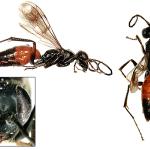Until recently this species was known as gracilis Haupt, 1927 (Wahis, 2006; Collins, 2010). The male is relatively distinctive on the subgenital plate, but the female belongs to the difficult group of Priocnemis.
In Britain this species is predominantly south-eastern, but with scattered records across to Wales and north to Yorkshire. Recorded from Ireland in O’Connor et al. (2009). Not recorded from the Channel Islands.
Overseas it occurs in central Europe (Wolf, 1972), France, Italy, Belgium, Netherlands, Germany, Austria, Denmark, Poland, Czech Republic, Slovakia and Romania (Wahis, 2011). Wiśniowski (2009) adds Finland, Sweden and Hungary, also Turkey and Siberia.
This species was listed as Rare (RDB3) by Shirt (1987), but revised to Nationally Notable/Nb (now known as Nationally Scarce) by Falk (1991). Current data suggest that it is scarce but not of conservation concern.
Day (1988) describes it as a species of woodland, and more open ground, on heavy clay. In Surrey, many of the records are from sandy areas (Baldock, 2010). In the Netherlands it seems to avoid clay soils but has been recorded on sands and loess (an accumulation of wind-blown silt with sand and clay, often calcareous) (Lefeber & van Ooijen, 1988), and it also favours loess in Poland (Wiśniowski, 2009).
Occurs most frequently in July and August, with smaller numbers in June and September.
There is very little data on the spider prey. A Kentish female was recorded with an immature Clubiona (Clubionidae). Spiders of the family Salticidae have also been recorded on the continent.
There is no data. Related species nest in soil, in pre-existing cavities.
There is little specific data. Priocnemis in general frequent white umbellifers, and confusor was amongst the species attracted to wild carrot lures on Surrey heathland (D Baldock, pers. comm.).
2016


